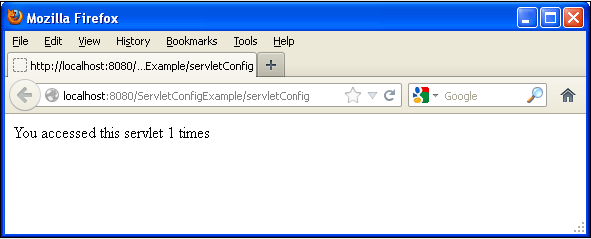Java ServletConfig Interface
In this tutorial, we will discuss about ServletConfig Interface.
In this tutorial, we will discuss about ServletConfig Interface.Java ServletConfig Interface
In this tutorial, we will discuss about ServletConfig Interface.
ServletConfig Interface :
The servlet container uses a ServletConfig object to pass initialization information to the servlet. In general it is used to read the initialization parameters so whenever server wants to pass initialization data to a servlet, it creates a class which implements this interface.
This interface has following four methods -
- getInitParameter(java.lang.String name) : It returns String holding value of the named initialization parameter. If parameter doesn't exist, it will return null.
- getInitParameterNames() : This method returns enumeration of String objects of all initialization parameter names. If servlet has no initialization parameters then it will return an empty Enumeration.
- getServletContext() : It returns an object of the ServletContext in which the caller is executing.
- getServletName() : It returns the name of the servlet instance.
Example :
ServletConfigExample.java
import java.io.*;
import javax.servlet.*;
import javax.servlet.http.*;
public class ServletConfigExample extends HttpServlet {
int counter;
public void init() throws ServletException {
String initValue = getServletConfig().getInitParameter("count");
counter = Integer.parseInt(initValue);
}
protected void doGet(HttpServletRequest request,
HttpServletResponse response) throws ServletException, IOException {
response.setContentType("text/html");
PrintWriter out = response.getWriter();
counter++;
out.println("You accessed this servlet " + counter + " times");
}
}
web.xml -
<?xml version="1.0" encoding="UTF-8"?> <web-app xmlns:xsi="http://www.w3.org/2001/XMLSchema-instance" xmlns="http://java.sun.com/xml/ns/javaee" xmlns:web="http://java.sun.com/xml/ns/javaee/web-app_2_5.xsd" xsi:schemaLocation="http://java.sun.com/xml/ns/javaee http://java.sun.com/xml/ns/javaee/web-app_2_5.xsd" id="WebApp_ID" version="2.5"> <display-name>ServletConfigExample</display-name> <servlet> <servlet-name>ServletConfigExample</servlet-name> <servlet-class>ServletConfigExample</servlet-class> <init-param> <param-name>count</param-name> <param-value>0</param-value> </init-param> </servlet> <servlet-mapping> <servlet-name>ServletConfigExample</servlet-name> <url-pattern>/servletConfig</url-pattern> </servlet-mapping> </web-app>
Output :
